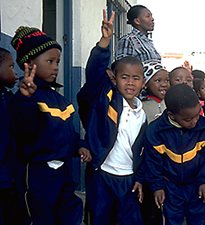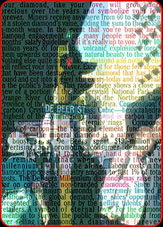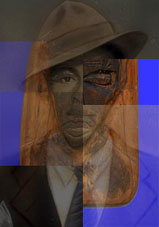
|
"Mountain view in the city of Cape Town "
© Colette Gaiter
|
|
|
|

|
"Children at a township pre-school "
© Colette Gaiter
|
|
|
"The Natural Order of Things" is my personal meditation on South African and U.S. society and culture after spending two weeks in South Africa in August of 1999. I looked at this country that is so similar and different from mine, through several different lenses. I was an African American woman on my first trip to Africa. I came to understand, in a way that was previously inaccessible to me, some of the differences between people of African descent who are connected to their ancestry and tribal culture and those of us thoroughly assimilated into the ways and values of the West.
South Africa is a country that through artificial social engineering, lives in two separate worlds. It is a "first world" Western, resource-rich, industrialized country, and a "third world" struggling country, unable to provide basic services for a huge number of people. In the streets of downtown Cape Town, pastel-colored well-kept buildings make the landscape look very much like any picturesque European city and the faces are mostly white. In the rural areas and black townships, tattered colored plastic bags fly like flags from trees and bushes. After a while, I started to think of them as indigenous flowers -- markers for lack of garbage collection. During my visit, the government voted to ban them, in an effort to reduce the ubiquitous trash pollution.
Black African people carry large parcels on their heads as they walk along the sides of the roads or wait at taxi stands for minibuses called "combis" that provided scarce transportation. The wide cultural range is clear in the combination of traditional tribal face painting and cell phones attached to waistbands. I suppose this is truly the natural order of things -- holding on to what seems essential from the old world while acquiring what seems necessary for the new.
The racial category of "coloured" people was a fascinating concept to me. In the U.S., the choices of racial affinity are usually black, white, Hispanic, Asian, Native American, or other. In addition to visualizing the huge amount of race mixing that has gone on in South Africa, these people also represent the middle ground of assimilation. Here in the U.S., we ignore the blatant evidence of race mixing, past and present, consensual and forced, and divide definitively among black, white, and other.

|
" Exhibit at Museum Africa, Johannesburg. A black maid with feather duster in
hand wears a sign that says, " What is she thinking? " Her employer says, " Whatis he thinking ? " as they listen to news about apartheid resistance. "
© Colette Gaiter
|
|
|
|

|
" Facts about diamond mining superimposed on a photo of a black maid walking down DeBeer street in Johannesburg "
© Colette Gaiter
|
|
|
I am interested in apartheid as an extreme version of United States racism and the idea of race as constructed by societal systems. "The Natural Order of Things" alludes to rationalizations made for centuries around the world by one group of people who believe it is divinely determined that they should dominate another group of people. We are all complicit in allowing this theory to operate, with or without cognitive awareness.
In an interview with white Johannesburg high school students in the early 1980s, at the height of the struggle against apartheid, a girl said:
"I hate the way other countries are always saying that we're racialist. Because even in America or Britain, I don't think the blacks are treated the same as whites. They have these faction fights all the time. Look at Ireland -- they're about ten times worse than we are. But the rest of the world is always condemning us. It's just that we've got our laws written down. In other countries they don't have laws like us, but they act exactly the way we do. Even worse, much worse." 1
What this girl did not know is that we had our segregation laws in the U.S. written down until the Civil Rights Act of 1964 overturned most of them. Societies carefully construct and enforce rules and laws to define a value system. My site mirrors South African laws -- such as the Immorality Act, that forbade interracial dating and marriage -- with laws from the pre-civil rights American South. These laws specifically forbade "miscegenation," burying blacks and whites in the same cemetery, seating blacks and whites too close together in restaurants, playing pool together -- meticulously covering most activities people of different races might possibly engage in together. The southern states wrote down, like apartheid South Africa, what the rest of the U.S. tacitly enforced. I marvel at the inherent contradiction in the idea that people of different races, classes and ethnic groups "naturally" want to remain separate, yet societies go to great lengths to ensure their separation. What exactly is the natural order of things?
Mythology is a recurring theme in my work -- specifically how societies use mythology to rationalize the irrational. Mythology itself is benign and probably necessary, but its specific applications can be diabolical. The apartheid government used mythology in an extreme way, constructing "truths" that seemed to naturalize even the most horrific lies. In the site, I use stories from my experiences and interactions with people on my trip to illuminate some particular piece of myth that is slowly being deconstructed. For example, accommodations for live-in African maids (a small room next to the garage with no heat or hot water) seem adequate when whites are taught to believe these amenities are not important to black people. It is part of the natural order of things.
I was struck by the direct language of post-apartheid South Africa, in contrast to our carefully maintained euphemistic codes. The government admits to "gross violations of human rights" during the apartheid years from 1948 until free elections in 1994. Verbal pretense seems obvious and ridiculous after a country has been through a kind of war. South Africa is wrestling with its racial demons -- something we have yet to do here in the land of the free and home of the brave. After a prolonged and relentless attack on the bodies and souls of non-white South Africans, some promise of honesty, truth, and acceptance emerged in the debris of this undeclared civil war that contains the essence of hope. Using a combination of media, my intention is to slowly and thoughtfully look at what we in the United States might learn from this country that was the object of our disdain for so many years.

|
" Interactive image -- African carving of a man/photograph of African American man "
© Colette Gaiter
|
|
|
Further information on Colette Gaiter's work at : http://www.mcad.edu/cgaiter
1 Frederickse, Julie. South Africa: A Different Kind of War. Johannesburg: Ravan Press. 1986.









